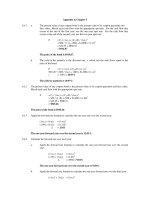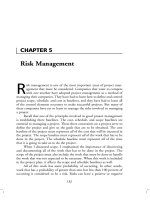Chapter 5 pptx
Bạn đang xem bản rút gọn của tài liệu. Xem và tải ngay bản đầy đủ của tài liệu tại đây (282.72 KB, 31 trang )
© 2008 Pearson Prentice Hall, Electronic Commerce 2008, Efraim Turban, et al.
Chapter 5
B2B E-Commerce:
Selling and Buying in Private E-
Markets
5-2
Concepts and Characteristics of
B2B EC
business-to-business e-commerce
(B2B EC)
Transactions between businesses
conducted electronically over the
Internet, extranets, intranets, or private
networks; also known as eB2B
(electronic B2B) or just B2B
5-3
Concepts and Characteristics of
B2B EC
5-4
Concepts and Characteristics of
B2B EC
Types of transactions
spot buying-at prevailing market rate
strategic sourcing-based on long term
contracts
Types of materials
Direct – used to make product
Indirect – used to support production
5-5
Concepts and Characteristics of
B2B EC
Direction of trade
vertical marketplaces
Markets that deal with one industry or industry
segment (e.g., steel, chemicals)
horizontal marketplaces
Markets that concentrate on a service, materials,
or a product that is used in all types of industries
(e.g., office supplies, PCs)
5-6
Concepts, Characteristics,
and Models of B2B EC
The Benefits of B2B
Creates new sales (purchase) opportunities
Eliminates paper and reduces administrative costs
Expedites processing and reduces cycle time
Lowers search costs and time for buyers to find
products and vendors
Increases productivity of employees dealing with
buying and/or selling
Reduces errors and improves quality of services
Makes product configuration easier
Reduces marketing and sales costs (for sellers)
5-7
Concepts, Characteristics,
and Models of B2B EC
5-8
Sell-Side Marketplaces
(one-to-many)
Marketing Characteristics
selling from electronic catalogs (often customized)
selling via forward auction
one-to-one selling (usually under a negotiated long term contract)
Seller
Company
C
Company
B
Company
A
5-9
Sell-Side Marketplaces (one-to-
many)
Examples
Microsoft’s order entry tool (MOET)
Cisco’s Connection Online (CCO)
Benefits:
lower operating costs
improved quality
better and faster technical service
reduced software packaging costs
5-10
Selling via
Intermediaries and Distributors
Manufacturers frequently use
intermediaries to distribute their products
to a large number of buyers, known as
distributors
The intermediaries usually buy products
from many vendors and aggregate them
into one catalog from which they sell
Now, many of these distributors also are
selling online
5-11
Sell-Side Marketplaces
(one-to-many)
Intermediary
Distributor
Grainger.com (horizontal markets)
Boeing PART (vertical market)
Auctioneer
links buyers and sellers
buyers may be less suspicious of products sold by auctioneers
handles billing and collection
Intermediary
Company
C
Company
B
Company
A
Seller
5-12
Selling via Auctions
Auctioning from the Company’s Own
Site
Why should a company pay a commission
to an intermediary if the intermediary cannot
provide the company with added value
If a company decides to auction from its
own site, it will have to pay for infrastructure
and operate and maintain the auction site
5-13
One-from-Many: Buy-Side E-Marketplaces
and E-Procurement
buy-side e-marketplace
A corporate-based acquisition site that
uses reverse auctions, negotiations,
group purchasing, or any other e-
procurement method
5-14
Buy Side Marketplaces
(one-to-many)
Six Main Types of E-Procurement
e-sourcing
e-tendering
e-reverse auctioning
e-informing
Web-based ERP (electronic resource planning)
e-MRO (maintenance, repair and operating)
Buyer
Company
C
Company
B
Company
A
5-15
One-from-Many: Buy-Side E-Marketplaces
and E-Procurement
Inefficiencies in Traditional Procurement
Management
procurement management
The planning, organizing, and coordination of all
the activities relating to purchasing goods and
services needed to accomplish the mission of an
organization
maverick buying
Unplanned purchases of items needed quickly,
often at non-prenegotiated higher prices
5-16
One-from-Many: Buy-Side E-Marketplaces
and E-Procurement
5-17
One-from-Many: Buy-Side E-Marketplaces
and E-Procurement
e-procurement
The electronic acquisition of goods and
services for organizations
5-18
One-from-Many: Buy-Side E-Marketplaces
and E-Procurement
5-19
One-from-Many: Buy-Side E-Marketplaces
and E-Procurement
The Goals and Benefits of E-Procurement
Increasing the productivity of purchasing agents
Lowering purchase prices
Improving information flow and management
Minimizing the purchases made from non-contract
vendors
Improving the payment process and savings due to
expedited payments
Establishing efficient, collaborative supplier relations
Ensuring delivery on time, every time
Slashing order-fulfillment and processing times by
leveraging automation
5-20
One-from-Many: Buy-Side E-Marketplaces
and E-Procurement
The Goals and Benefits of E-Procurement
Reducing the skill requirements and training needs of purchasing
agents
Reducing the number of suppliers
Streamlining the purchasing process,
Streamlining invoice reconciliation and dispute resolution
Reducing the administrative processing cost per order
Finding new suppliers and vendors that can provide goods and
services faster and/or cheaper (improved sourcing)
Integrating budgetary controls into the procurement process
Minimizing human errors in the buying or shipping processes
Monitoring and regulating buying behavior
5-21
One-from-Many: Buy-Side E-Marketplaces
and E-Procurement
Implementing E-Procurement
Fitting e-procurement into the company’s EC strategy
Reviewing and changing the procurement process
itself
Providing interfaces between e-procurement and
integrated enterprisewide information systems, such
as ERP or supply chain management
Coordinating the buyer’s information system with that
of the sellers
Consolidating the number of regular suppliers and
integrating with their information systems and, if
possible, with their business processes
5-22
One-from-Many: Buy-Side E-Marketplaces
and E-Procurement
e-sourcing
The process and tools that electronically
enable any activity in the sourcing
process, such as quotation/tender
submission and response, e-auctions,
online negotiations, and spending
analyses
5-23
Buy-Side E-Marketplaces:
Reverse Auctions
request for quote (RFQ)
The “invitation” to participate in a
tendering (bidding) system
5-24
Buy-Side E-Marketplaces:
Reverse Auctions
5-25
Other E-Procurement Methods
internal procurement marketplace
The aggregated catalogs of all approved
suppliers combined into a single internal
electronic catalog
desktop purchasing
Direct purchasing from internal
marketplaces without the approval of
supervisors and without the intervention of
a procurement department (p-card)









